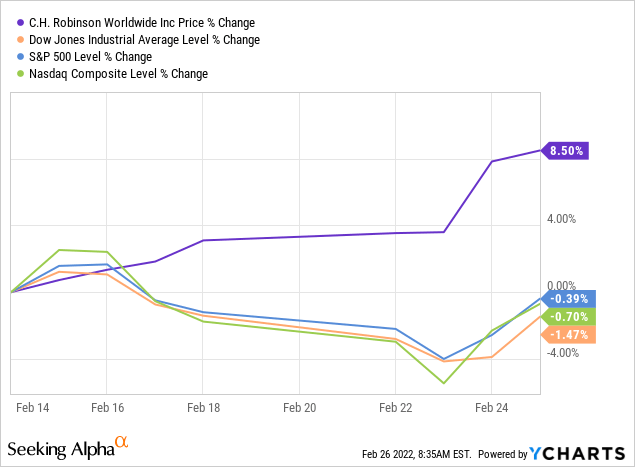Abstract Aerial Art/DigitalVision via Getty Images
The history of drones, a.k.a. “Unmanned Aerial Vehicles” or UAVs, is a military story. It dates to the 1800s and their use above ground for surveillance, target practice, and even balloon bombing. Fast forward to World War II and their use to train aircraft gunners, and later, to prevent the deaths of pilots flying high-risk missions. One of President Obama’s signature achievements was using drones to replace “boots on the ground.” Drones are even now finding midair use to refuel other aircraft. It seems inevitable that UAVs will eventually replace cockpit pilots.
Commercial Trucking
As is often the case with technologies developed by the DOD and its contactors, they eventually find their way into commercial use as is the case with UAVs for crop and disaster/insurance evaluation, and even art and entertainment when ‘orchestrated’ in large numbers. But this stuff is nickel ante. Significant business benefits of unmanned vehicle technology will come as it supplants paid labor in moving whatever from/to wherever.
Take over-the-road trucking. This article breaks down the approximate $180,000 annual cost to operate a large truck. Aside from fuel, the second largest line item is for drivers.
|
39% |
$70,200 |
Fuel |
|
26% |
46,800 |
Driver Salary |
|
11% |
19,800 |
Truck Cab |
|
5% |
9,000 |
Trailer |
|
10% |
18,000 |
Maintenance |
|
4% |
7,200 |
Insurance |
|
3% |
5,400 |
Tires |
|
2% |
3,600 |
Permits |
|
100% |
$180,000 |
Total |
With millions of trucks registered, it doesn’t take a math degree to realize that the cost takeout represented by drone trucks could climb well into the billions. Below, I have abbreviated and tipped on its side this table from the Bureau of Transportation to show the spectrum of trucks and their respective numbers in just the U.S.:
|
Light |
Heavy |
|
|
Pickups |
Vans |
Medium+ |
|
48 million |
15 million |
12 million |
The move to self-driving trucks will build from the right end of the spectrum – with medium and heavy trucks – where the expense reduction opportunities are the largest. Moreover, I suspect their initial use will be on long-haul, interstate, terminal-to-terminal routes. Shorter, more complex, smaller vehicle, city driving will come later, IMO. I will leave it to readers to push around and extrapolate these potential benefit dollars so can we turn our focus on an investment opportunity.
C.H. Robinson Worldwide
C.H. Robinson (CHRW) is one of the largest shipping and logistics management companies on earth. The company is a supply-chain facilitator. Their “global technology system” and staff of 17,000 bring together 100,000 customers with 85,000 providers to move goods. Their services cover “truckload, less than truckload, intermodal, ocean, air, customs brokerage, sourcing and managed services.” Got a shipment, but don’t have a truck/driver, call or log-on to C.H. Robinson, problem solved. My sources tell me that this company is exceptionally good and commands a pretty penny for their services. Nothing wrong with that.
Now, step back and consider the company’s February 16th announcement with Alphabet/Waymo (GOOG) (GOOGL) forming, “a long-term strategic partnership to mutually explore the practical application of autonomous driving technology in logistics and supply chains. The partnership combines the benefits of Waymo’s innovative autonomous driving technology, the Waymo Driver, with C.H. Robinson’s Navisphere technology, which is the world’s most-connected logistics platform.” As Charlie Jatt, Head of Commercialization for Trucking at Waymo, put it:
“We look forward to this collaboration with C.H. Robinson, both for their deep roots and experience in logistics and transportation, but also as a company that shares our vision of how technology and autonomous trucking can change our industry for the better,” … “C.H. Robinson’s size, scale and platform gives us access to rich and unique transportation data along with customer relationships and pilot opportunities to help bring our Waymo Via solution to the market.”
Waymo’s technological contributions to this collaboration are critical. Their self-driving systems are grounded on positioning/Google Maps and extend to a variety of sensors: a) light/cameras, b) sound/sonar, c) radio wave echoes/radar, and d) lasers for 3D detection and ranging/LIDAR. These technologies complement C.H. Robinson’s logistical expertise. In other words, what if, when a customer calls in for a shipment, C.H. Robinson can now ask, ‘We can arrange for a driverless truck immediately, saving you $X thousand; would that work for you?’
Workers vs. Shareholders
In the backstory, we see carefully chosen words aimed partially, I presume, to mollify those who would think that this is all a plot to put truckers out of business. For example, as stated in the joint press release above, “During and after the pilots [Dallas/Houston], the companies will collaborate to shape the future development and expansion of autonomous driving technology as an additional transportation solution. This will provide much-needed capacity, help improve the carrier and driver experience and address the business challenges posed by long-term driver shortages.” On the one hand, it is illogical to believe how such an alliance can “improve the driver experience” for truckers who are no longer behind the wheel because they have lost their jobs to technology.
On the other hand, I can see that unmanned trucks may “address the business challenges posed by long-term driver shortages.” In fact, truckers are quitting in scores because of long hours, lack of downtime pay, and expensive benefits, notably healthcare, as those of us who have run owner/operator businesses know all too well. That said, the introduction and growth of surface drone technology may help truckers redefine their lives for the better as terminal parkers/dockers, downstream/local deliverers, or aggregators. Some may even find the ability to finance drone trucks and step away from driving altogether. Whatever the case, this evolution represents a continuation of the struggle between laborers and capitalists that political economists have described dating back to the Industrial Revolution.
Strategically, Fundamentally, Technically
As for C.H. Robinson, together with Waymo, the model that is coming into focus makes sense strategically. I also like the company and its stock for fundamental and technical reasons. In its latest financials, they reported healthy growth in revenue, gross profit, operating income, and net income. Operating cash flow showed stress tied to accounts receivable, However, the company’s A/R losses and turnover are holding steady, so I am not concerned about it. Here’s a look at the basics financials compliments of SA:
|
2020 |
2021 |
Growth |
|
|
Total Revenues |
$16.2B |
$23.1 |
+43% |
|
Gross Profit |
$1.2B |
$1.6B |
+33% |
|
Operating Income |
$673M |
$1.1B |
+63% |
|
Net Income |
$506M |
$844M |
+67% |
|
Op. Cash Flow |
$499M |
$95M |
-81% |
|
Working Capital |
$1.1B |
$1.5B |
n/a |
|
Current Ratio |
1.6x |
1.4x |
n/a |
|
Liabs. to Equity |
1.7x |
2.5x |
n/a |
As for value and income, CRHW trades at a P/E of 15.4x and pays a dividend of 2.3% with a conservative payout ratio of 33%. Of the 26 professional analysts that cover the stock, MarketWatch reports that 9 rate it a “buy”, 1 an “overweight”, 14 a “hold”, with no “underweights”, and 2 a “sell”. Their average price target is $103 placing the stock 6% above Friday’s close.
Interestingly, CHRW dropped $15.48 or 15% within 2 days of its February 1st earnings release. However, following their Waymo announcement, again on February 16th, the stock appears to have put in a bottom and is rising as the chart below demonstrates. Consistent with its beta of .61, this stock is now bucking downward market pressures brought about by the threat of rising interest rates and geopolitical tensions emanating out of Ukraine.

So, there you have it, an essential company at the intersection of critical supply-chain activities and now in alliance with one of world’s top motion/AI technologists to deliver the promise of self-driving trucks. I can’t think of many investments that are as well-aligned for the times, both defensively and offensively.

